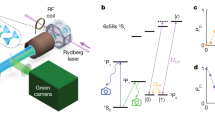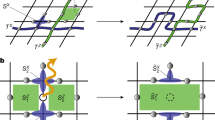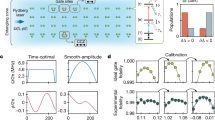Abstract
The development of quantum computing architectures from early designs and current noisy devices to fully fledged quantum computers hinges on achieving fault tolerance using quantum error correction1,2,3,4. However, these correction capabilities come with an overhead for performing the necessary fault-tolerant logical operations on logical qubits (qubits that are encoded in ensembles of physical qubits and protected by error-correction codes)5,6,7,8. One of the most resource-efficient ways to implement logical operations is lattice surgery9,10,11, where groups of physical qubits, arranged on lattices, can be merged and split to realize entangling gates and teleport logical information. Here we report the experimental realization of lattice surgery between two qubits protected via a topological error-correction code in a ten-qubit ion-trap quantum information processor. In this system, we can carry out the necessary quantum non-demolition measurements through a series of local and entangling gates, as well as measurements on auxiliary qubits. In particular, we demonstrate entanglement between two logical qubits and we implement logical state teleportation between them. The demonstration of these operations—fundamental building blocks for quantum computation—through lattice surgery represents a step towards the efficient realization of fault-tolerant quantum computation.
This is a preview of subscription content, access via your institution
Access options
Access Nature and 54 other Nature Portfolio journals
Get Nature+, our best-value online-access subscription
$29.99 / 30 days
cancel any time
Subscribe to this journal
Receive 51 print issues and online access
$199.00 per year
only $3.90 per issue
Buy this article
- Purchase on Springer Link
- Instant access to full article PDF
Prices may be subject to local taxes which are calculated during checkout



Similar content being viewed by others
Data availability
The data that support the findings of this study are available at https://doi.org/10.5281/zenodo.4081412.
Code availability
All codes used for data analysis are available from the corresponding authors upon reasonable request.
References
Preskill, J. in Introduction to Quantum Computation (eds Lo, H.-K., Popescu, S. & Spiller, T. P.) Ch. 8, 213–269 (World Scientific, 1997).
Devitt, S. J., Munro, W. J. & Nemoto, K. Quantum error correction for beginners. Rep. Prog. Phys. 76, 076001 (2013).
Terhal, B. M. Quantum error correction for quantum memories. Rev. Mod. Phys. 87, 307–346 (2015).
Campbell, E. T., Terhal, B. M. & Vuillot, C. Roads towards fault-tolerant universal quantum computation. Nature 549, 172–179 (2017); correction 559, E6 (2018).
Gottesmann, D. Stabilizer Codes and Quantum Error Correction. Ph.D. thesis, Caltech (1997).
Gottesman, D. & Chuang, I. L. Demonstrating the viability of universal quantum computation using teleportation and single-qubit operations. Nature 402, 390–393 (1999).
Eisert, J., Jacobs, K., Papadopoulos, P. & Plenio, M. B. Optimal local implementation of nonlocal quantum gates. Phys. Rev. A 62, 052317 (2000).
Bravyi, S. & Kitaev, A. Universal quantum computation with ideal Clifford gates and noisy ancillas. Phys. Rev. A 71, 022316 (2005).
Poulsen Nautrup, H., Friis, N. & Briegel, H. J. Fault-tolerant interface between quantum memories and quantum processors. Nat. Commun. 8, 1321 (2017).
Gutiérrez, M., Müller, M. & Bermúdez, A. Transversality and lattice surgery: exploring realistic routes toward coupled logical qubits with trapped-ion quantum processors. Phys. Rev. A 99, 022330 (2019).
Horsman, C., Fowler, A. G., Devitt, S. & Van Meter, R. Surface code quantum computing by lattice surgery. New J. Phys. 14, 123011 (2012).
Chiaverini, J. et al. Realization of quantum error correction. Nature 432, 602–605 (2004).
Boulant, N., Viola, L., Fortunato, E. M. & Cory, D. G. Experimental implementation of a concatenated quantum error-correcting code. Phys. Rev. Lett. 94, 130501 (2005).
Zhang, J., Gangloff, D., Moussa, O. & Laamme, R. Experimental quantum error correction with high fidelity. Phys. Rev. A 84, 034303 (2011).
Wootton, J. R. & Loss, D. Repetition code of 15 qubits. Phys. Rev. A 97, 052313 (2018).
Bell, B. A. et al. Experimental demonstration of a graph state quantum error-correction code. Nat. Commun. 5, 3658 (2014).
Takita, M., Cross, A. W., Córcoles, A. D., Chow, J. M. & Gambetta, J. M. Experimental demonstration of fault-tolerant state preparation with superconducting qubits. Phys. Rev. Lett. 119, 180501 (2017).
Kelly, J. et al. State preservation by repetitive error detection in a superconducting quantum circuit. Nature 519, 66–69 (2015).
Linke, N. M. et al. Fault-tolerant quantum error detection. Sci. Adv. 3, e1701074 (2017).
Andersen, C. K. et al. Repeated quantum error detection in a surface code. Nat. Phys. 16, 875–880 (2020).
Aoki, T. et al. Quantum error correction beyond qubits. Nat. Phys. 5, 541–546 (2009).
Reed, M. D. et al. Realization of three-qubit quantum error correction with superconducting circuits. Nature 482, 382–385 (2012).
Waldherr, G. et al. Quantum error correction in a solid-state hybrid spin register. Nature 506, 204–207 (2014).
Ofek, N. et al. Extending the lifetime of a quantum bit with error correction in superconducting circuits. Nature 536, 441–445 (2016).
Stricker, R. et al. Experimental deterministic correction of qubit loss. Nature 585, 207–210 (2020).
Zhang, J., Laflamme, R. & Suter, D. Experimental implementation of encoded logical qubit operations in a perfect quantum error correcting code. Phys. Rev. Lett. 109, 100503 (2012).
Nigg, D. et al. Quantum computations on a topologically encoded qubit. Science 345, 302–305 (2014).
Barends, R. et al. Superconducting quantum circuits at the surface code threshold for fault tolerance. Nature 508, 500–503 (2014).
Heeres, R. W. et al. Implementing a universal gate set on a logical qubit encoded in an oscillator. Nat. Commun. 8, 94 (2017).
Gong, M. et al. Experimental verification of five-qubit quantum error correction with superconducting qubits. Preprint at http://arXiv.org/abs/1907.04507 (2019).
Hu, L. et al. Quantum error correction and universal gate set operation on a binomial bosonic logical qubit. Nat. Phys. 15, 503–508 (2019).
Chou, K. S. et al. Deterministic teleportation of a quantum gate between two logical qubits. Nature 561, 368–373 (2018).
Harper, R. & Flammia, S. T. Fault-tolerant logical gates in the IBM quantum experience. Phys. Rev. Lett. 122, 080504 (2019).
Dennis, E., Kitaev, A., Landahl, A. & Preskill, J. Topological quantum memory. J. Math. Phys. 43, 4452–4505 (2002).
Fowler, A. G., Mariantoni, M., Martinis, J. M. & Cleland, A. N. Surface codes: towards practical large-scale quantum computation. Phys. Rev. A 86, 032324 (2012).
Lekitsch, B. et al. Blueprint for a microwave trapped ion quantum computer. Sci. Adv. 3, e1601540 (2017).
Jones, N. C. et al. Layered architecture for quantum computing. Phys. Rev. X 2, 031007 (2012).
Herr, D., Nori, F. & Devitt, S. J. Optimization of lattice surgery is NP-hard. npj Quantum Inf. 3, 35 (2017).
Häner, T., Steiger, D. S., Svore, K. & Troyer, M. A software methodology for compiling quantum programs. Quantum Sci. Technol. 3, 020501 (2018).
Litinski, D. A game of surface codes: large-scale quantum computing with lattice surgery. Quantum 3, 128 (2019).
Nautrup, H. P., Delfosse, N., Dunjko, V., Briegel, H. J. & Friis, N. Optimizing quantum error correction codes with reinforcement learning. Quantum 3, 215 (2019).
Raussendorf, R. & Briegel, H. J. A one-way quantum computer. Phys. Rev. Lett. 86, 5188–5191 (2001).
Lanyon, B. P. et al. Measurement-based quantum computation with trapped ions. Phys. Rev. Lett. 111, 210501 (2013).
Wang, D. S., Fowler, A. G. & Hollenberg, L. C. L. Surface code quantum computing with error rates over 1%. Phys. Rev. A 83, 020302(R) (2011).
Schindler, P. et al. A quantum information processor with trapped ions. New J. Phys. 15, 123012 (2013).
Ejtemaee, S. & Haljan, P. C. 3D Sisyphus cooling of trapped ions. Phys. Rev. Lett. 119, 043001 (2017).
Friis, N. et al. Observation of entangled states of a fully controlled 20-qubit system. Phys. Rev. X 8, 021012 (2018).
Erhard, A. et al. Characterizing large-scale quantum computers via cycle benchmarking. Nat. Commun. 10, 5347 (2019).
Friis, N., Vitagliano, G., Malik, M. & Huber, M. Entanglement certification from theory to experiment. Nat. Rev. Phys. 1, 72–87 (2019).
Acknowledgements
We acknowledge support from the Austrian Science Fund (FWF) through SFB BeyondC (grant F71). H.P.N. and H.J.B. acknowledge support from FWF project DK-ALM (grant W1259-N27). H.J.B. was also supported by the Ministerium für Wissenschaft, Forschung, und Kunst Baden-Württemberg (AZ:33-7533.-30-10/41/1). N.F. acknowledges support from the FWF through project P 31339-N27. A.E., M.M., L.P., R.S., M.R., P.S., T.M. and R.B. acknowledge funding by the US Army Research Office (ARO) through grant no. W911NF-14-1-0103. We also acknowledge funding by the Austrian Research Promotion Agency (FFG) contract 872766, and by the EU H2020-FETFLAG-2018-03 under grant agreement no. 820495. M.S. and V.N. acknowledge funding by the Office of the Director of National Intelligence (ODNI), Intelligence Advanced Research Projects Activity (IARPA), via US ARO grant no. W911NF-16-1-0070. This project has received funding from the European Union’s Horizon 2020 research and innovation programme under the Marie Skłodowska-Curie grant agreement no. 801110 and the Austrian Federal Ministry of Education, Science and Research (BMBWF). We acknowledge support from the IQI GmbH. All statements of fact, opinions or conclusions contained herein are those of the authors and should not be construed as representing the official views or policies of the funding agencies.
Author information
Authors and Affiliations
Contributions
A.E., H.P.N., P.S. and N.F. wrote the manuscript and A.E., H.P.N., M.M., L.P., R.S., M.R., P.S., H.J.B., R.B., N.F. and T.M. provided revisions. A.E., H.P.N., P.S. and N.F. developed the research based on discussions with H.J.B., R.B. and T.M. H.P.N. and N.F. developed the theory. A.E. and P.S. performed the experiments. A.E., M.M., L.P., R.S., M.S., V.N., M.R., P.S., R.B. and T.M. contributed to the experimental setup. A.E., H.P.N., M.M., L.P., R.S., M.R., P.S., H.J.B., R.B., N.F. and T.M. contributed to discussions of the results and the manuscript.
Corresponding authors
Ethics declarations
Competing interests
T.M. and R.B. are founding members of Alpine Quantum Technologies GmbH.
Additional information
Peer review information Nature thanks Rodney Van Meter, Theodore Yoder and the other, anonymous, reviewer(s) for their contribution to the peer review of this work. Peer reviewer reports are available.
Publisher’s note Springer Nature remains neutral with regard to jurisdictional claims in published maps and institutional affiliations.
Extended data figures and tables
Extended Data Fig. 1 Standard surface code of distance 3.
The standard surface code is defined on a square lattice with (data) qubits located on vertices. Stabilizers are associated with faces and boundaries. Aquamarine faces and boundaries indicate Z-type stabilizers, as in equation (6). Red faces and boundaries indicate X-type stabilizers, as in equation (5). The surface code with boundaries encodes a single logical qubit defined by its logical Pauli-X and Pauli-Z operators. These operators are defined on paths connecting opposite boundaries of the lattice and act as products of X- and Z-operators, respectively, along the paths. Here, two representative logical operators are drawn as products of Pauli-operators within the dashed rectangles. Red indicates Pauli-X operators and green indicates Pauli-Z operators. The two operators anti-commute at the crossing drawn in yellow.
Extended Data Fig. 2 Fault-tolerant logic gates with lattice surgery.
Lattice surgery (LS) enables measurement-based implementations of logic gates and logical state teleportation. LS operations are logical joint measurements of the form \({M}_{P\mathop{P}\limits^{ \sim }}=({\mathbb{I}}\pm P\mathop{P}\limits^{ \sim })/2\) where \(P,\mathop{P}\limits^{ \sim }\) are Pauli operators. Moreover, the protocols make use of single-qubit measurements of the form MP = (\({\mathbb{I}}\) ± P)/2. Thick lines indicate logical qubits in the circuit model and double lines represent classical bits indicating measurement outcomes mi = 0, 1. Pauli corrections need to be applied which are conditioned on the measurement outcomes as \({P}_{{\rm{L}}}^{{m}_{i}}\). The symbol ⊕ represents an XOR-gate between classical bits. a, Measurement-based implementation of a logical CNOT-gate between arbitrary control and target qubits requiring an auxiliary qubit in the |+L⟩ state. b, Measurement-based teleportation protocol for state teleportation between two logical qubits using X-type LS. c, Measurement-based implementation of a logical Hadamard gate H based on the teleportation protocol.
Extended Data Fig. 3 Surface code lattice surgery in theory.
Surface code LS between Z-type and X-type boundaries implementing logical joint measurements \({M}_{{\rm{XX}}}^{\pm }=({\mathbb{I}}\pm {X}_{{\rm{L}}}^{{\rm{A}}}{X}_{{\rm{L}}}^{{\rm{B}}})/2\) (a) and \({M}_{{\rm{ZZ}}}^{\pm }=({\mathbb{I}}\pm {Z}_{{\rm{L}}}^{{\rm{A}}}{Z}_{{\rm{L}}}^{{\rm{B}}})/2\) (b), respectively. A, Encoded. The two initial surface codes are defined on 2 × 2 lattices where X-stabilizers are associated with orange faces and Z-stabilizers with aquamarine faces in accordance with equation (1). Logical operators are products of Pauli operators connecting opposite boundaries as in equation (2). a, Z-type encoded. The two surface codes are arranged such that they are aligned along their Z-type boundary. b, X-type encoded. The surface codes are aligned along their X-type boundary. B, Merged. Treating the two codes as a single (asymmetric) surface code, (merging) stabilizers along the boundaries are measured. The merged code encodes a single logical qubit corresponding to the logical Pauli operators \({X}_{{\rm{L}}}^{{\rm{M}}},{Z}_{{\rm{L}}}^{{\rm{M}}}\). a, Z-type merged. Merging stabilizers (indicated in red) are chosen such that their product is \({X}_{{\rm{L}}}^{{\rm{A}}}{X}_{{\rm{L}}}^{{\rm{B}}}\). b, X-type merged. Merging stabilizers (indicated in green) are chosen such that their product is \({Z}_{{\rm{L}}}^{{\rm{A}}}{Z}_{{\rm{L}}}^{{\rm{B}}}\). C, Split. In order to split the merged code while preserving the eigenstate of the joint logical operator, the boundary stabilizers of the original code are measured. These operators anti-commute with the merging stabilizers and thus project onto the individual codes. Since the boundary operators commute with individual logical operators, the resulting state remains an eigenstate of the joint logical operator. a, Z-type split. Measuring Z-stabilizers along the boundary (indicated in green) preserves the eigenstate of \({X}_{{\rm{L}}}^{{\rm{A}}}{X}_{{\rm{L}}}^{{\rm{B}}}\) while projecting onto the individual codes. b, X-type split. Measuring X-stabilizers along the boundary (indicated in red) preserves the eigenstate of \({Z}_{{\rm{L}}}^{{\rm{A}}}{Z}_{{\rm{L}}}^{{\rm{B}}}\) while projecting onto the individual codes.
Extended Data Fig. 4 Experimental X-type surface code lattice surgery.
Bell state generation via lattice surgery along the X-type boundary between two surface code qubits through a logical joint measurement \({M}_{{\rm{ZZ}}}^{+}\propto {\mathbb{I}}+{Z}_{{\rm{L}}}^{{\rm{A}}}{Z}_{{\rm{L}}}^{{\rm{B}}}\). Post-selected measurements are presented in light coloured bars. A, Encoded. Two logical qubits (a) are encoded with average stabilizer values (b) of ⟨|Si|⟩ = 0.813(4). We observe raw and post-selected state fidelities (c) of \( {\mathcal F} (|{0}_{{\rm{L}}}^{{\rm{A}}}\rangle )=93.3(5)|98.7(2){\rm{ \% }}\) for logical qubit A and \( {\mathcal F} (|{0}_{{\rm{L}}}^{{\rm{B}}}\rangle )=92.4(5)|97.9(3){\rm{ \% }}\) for logical qubit B. B, Merged. The two separated logical qubits are merged (a) into a single logical qubit by measuring the stabilizer \({S}_{7}^{{\rm{M}}}\) using auxiliary qubit A1 as syndrome qubit. Thereby, the code space is extended in the vertical direction and the new logical operator \({X}_{{\rm{L}}}^{{\rm{M}}}={X}_{{\rm{L}}}^{{\rm{A}}}{X}_{{\rm{L}}}^{{\rm{B}}}\) is formed. As the data show, the stabilizer \({S}_{7}^{{\rm{M}}}\) is indeed created. The average stabilizer values (b) are ⟨|Si|⟩ = 0.719(5) and logical state fidelities (c) are \( {\mathcal F} (|{+}_{{\rm{L}}}^{{\rm{M}}}\rangle )=76.2(8)|93.1(6){\rm{ \% }}\). C, Split. The single logical qubit is again split into two logical qubits (a) along the same boundary they have been initially merged through. We measure the stabilizer \(\bar{S}{}_{6}^{{\rm{M}}}\) by using auxiliary qubit A2 as syndrome qubit to perform the splitting and obtain average stabilizer values (b) of ⟨|Si|⟩ = 0.763(5). The fidelity (c) of the generated state to the logical Bell state is \( {\mathcal F} (|{\psi }_{{\rm{L}}}^{+}\rangle )=63.9(2.8)|78.0(2.7){\rm{ \% }}\). Note that measuring the merging stabilizer \({S}_{7}^{{\rm{M}}}\) = \({Z}_{{\rm{L}}}^{{\rm{A}}}{Z}_{{\rm{L}}}^{{\rm{B}}}\) directly projects onto a joint eigenstate of the logical Z-operators such that the splitting becomes redundant. Nevertheless, the general procedure as described in Methods requires the measurement of X-stabilizers along the boundary which is why it is still included here.
Supplementary information
Supplementary Information
This file contains additional details on the performed experiment.
Rights and permissions
About this article
Cite this article
Erhard, A., Poulsen Nautrup, H., Meth, M. et al. Entangling logical qubits with lattice surgery. Nature 589, 220–224 (2021). https://doi.org/10.1038/s41586-020-03079-6
Received:
Accepted:
Published:
Issue Date:
DOI: https://doi.org/10.1038/s41586-020-03079-6
This article is cited by
-
Protecting entanglement between logical qubits via quantum error correction
Nature Physics (2024)
-
Autonomous error correction of a single logical qubit using two transmons
Nature Communications (2024)
-
Heralded entanglement between error-protected logical qubits for fault-tolerant distributed quantum computing
Science China Physics, Mechanics & Astronomy (2024)
-
Quantum networks with neutral atom processing nodes
npj Quantum Information (2023)
-
Noisy intermediate-scale quantum computers
Frontiers of Physics (2023)
Comments
By submitting a comment you agree to abide by our Terms and Community Guidelines. If you find something abusive or that does not comply with our terms or guidelines please flag it as inappropriate.



